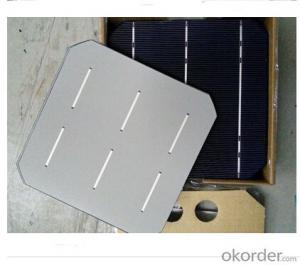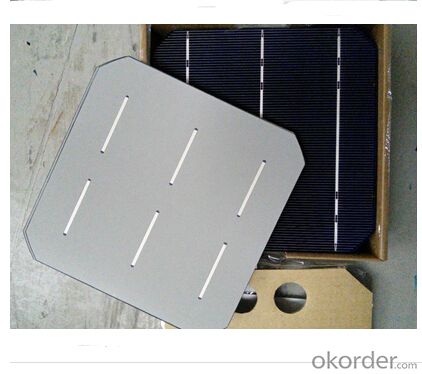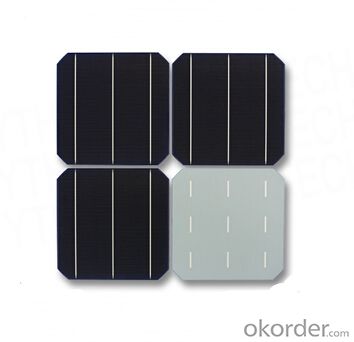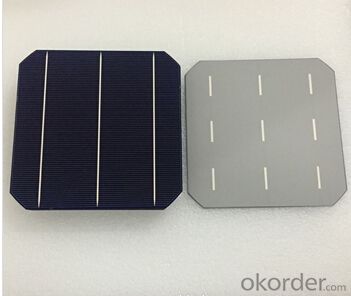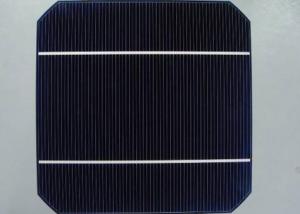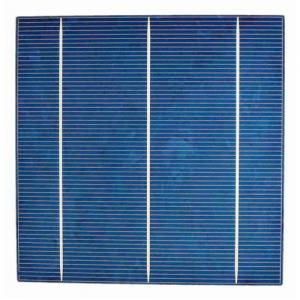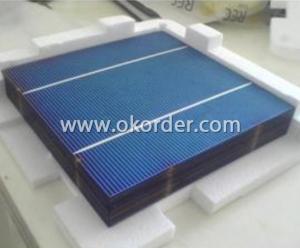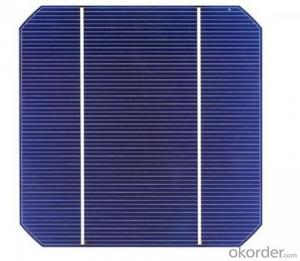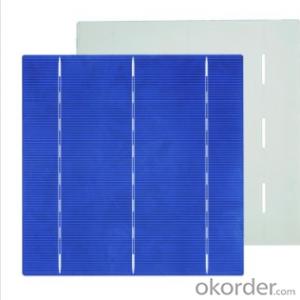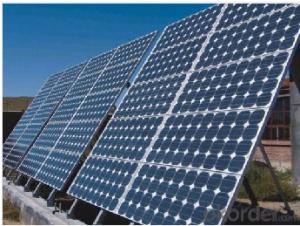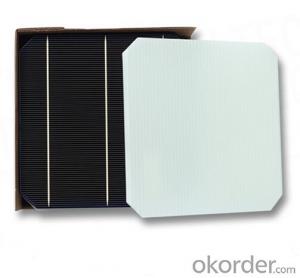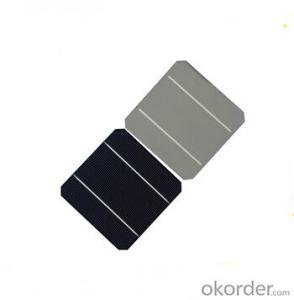Topcon A Grade 16.6% Monocrystalline Solar Cells
- Loading Port:
- Shanghai
- Payment Terms:
- TT OR LC
- Min Order Qty:
- 5000 pc
- Supply Capability:
- 80000 pc/month
OKorder Service Pledge
OKorder Financial Service
You Might Also Like
Monocrystalline Solar Cells A GRADE:
Solar cells is made by solar wafer, it has three categories of solar cell right now, monocrystalline polycrystalline and thin film,These cells are entirely based around the concept of ap-n junction, which is the critical part of solar module, it is the part that can convert the light energy into electricity, the thickness is from 180um to 200um, with even busbars to conduct electricity, textured cell can decrease diffuse reflection; they are often electrically connected and encapsulated as a module. Photovoltaic modules often have a sheet of glass on the front (sun up) side, allowing light to pass while protecting semiconductor wafers from abrasion and impact due to wind-driven debris, rain, hail, etc. Solar cells are also usually connected in series in modules, creating an additive voltage. Connecting cells in parallel will yield a higher current;With high quality and stable quality. Our Cells can greatly improve the performance of Solar Modules.
Monocrystalline Silicon Solar Cells A GRADE Advantage:
• High efficiency and stable performance in photovoltaic conversion.
• Advanced diffusion technique ensuring the homogeneity of energy conversion efficiency of the cell.
• Advanced PECVD film forming, providing a dark blue silicon nitride anti-reflection film of homogenous color and attractive appearance.
• High quality metal paste for back surface and electrode, ensuring good conductivity, high pulling strength and ease of soldering.
• High precision patterning using screen printing, ensuring accurate busbar location for ease with automatic soldering a laser cutting.
Specifications of Monocrystalline Solar Cells
Efficiency (%) Pmpp (W) Umpp (V) Impp (A) Uoc (V) Isc (A) |
18.20% 4.43 0.536 8.263 0.634 8.712 |
18.00% 4.38 0.535 - 8.188 0.633 8.701 |
17.80% - 4.33 0.534 - -8.112 ---0.632 ----8.652 |
17.60% 4.28 0.533 8.036 0.631 8.641 |
17.40% 4.23 0.529 8.005 0.630 8.591 |
17.20% 4.19 0.525 7.973 0.627 8.542 |
17.00% 4.14 0.522 7.926 0.624 8.495 |
16.80% 4.09 0.518 7.893 0.620 8.452 |
16.60% 4.04 0.515 7.844 0.617 8.410 |
Monocrystalline Solar Cells
Solar cells are often electrically connected and encapsulated as a module. Photovoltaic modules often have a sheet of glass on the front (sun up) side, allowing light to pass while protecting the semiconductor wafers from abrasion and impact due to wind-driven debris, rain, hail, etc. Solar cells are also usually connected in series in modules, creating an additive voltage. Connecting cells in parallel will yield a higher current; our solar cells have passed IEC Certification. With high and stable quality, our cells can greatly improve the performance of Solar Modules.
Applications of Monocrystalline Solar Cells
Assemblies of photovoltaic cells are used to make solar modules which generate electrical power from sunlight, as distinguished from a "solar module" or "solar panel". A solar array generates solar power using solar energy.
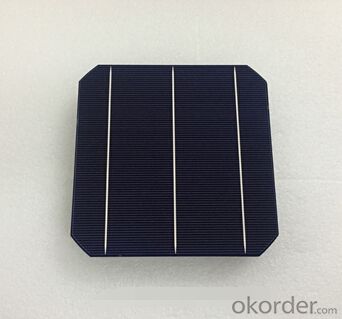
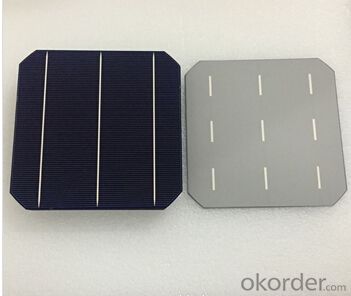
FAQ
We have organized several common questions for our clients,may help you sincerely:
①What price for each watt?
It depends on the efficiency of the solar cell, quantity, delivery date and payment terms.
②How long can we receive the product after purchase?
In the purchase of product within three working days, We will arrange the factory delivery as soon as possible. The pecific time of receiving is related to the state and position of customers.Commonly 7 to 10 working days can be served.
③Can you provide the peripheral products of the solar panels, such as the battery, controller, and inverter? If so, can you tell me how do they match each other?
Yes, we can, we have two companies for solar region, one is CNBM International, the other is CNBM engineering Co.
We can provide you not only the solar module but also the off grid solar system, we can also provide you service with on grid plant.
④What is your warranty of solar cell?
Our product can promise lower than 0.3% open box crack, we support claim after opening the box if it has crackm color difference or sth, the buyer should give pictures immediately, we can not accept the claim after the solar cell has assembled to solar panel.
• Timeliness of delivery
• ⑤How do you pack your products?
We have rich experience on how to pack the solar cell to make sure the safety on shipment, we could use wooden box or pallet as buyer's preference.
⑥ Can you do OEM for us?
Yes, we can.
- Q: Can solar cells be used to power wireless communication networks?
- Yes, solar cells can be used to power wireless communication networks. Solar cells are capable of converting sunlight into electricity, which can be stored in batteries or directly used to power various devices, including wireless communication equipment. This renewable energy source offers a sustainable and environmentally friendly solution for powering wireless networks in remote or off-grid locations. Additionally, advancements in solar cell technology have made them more efficient and cost-effective, making them a viable option for powering these networks.
- Q: How do solar cells generate electricity?
- Solar cells generate electricity through the photovoltaic effect, where the cells convert sunlight directly into electrical energy. The cells are made of semiconducting materials, usually silicon, which absorb photons from the sunlight. These photons excite the electrons in the material, causing them to break free from their atoms and create an electric current. This current is then collected and used to power various devices or stored in batteries for later use.
- Q: The advantages and effects of solar energy
- The advantages of solar energy: solar energy as a new energy, it has three characteristics compared with conventional energy: First: it is the most abundant energy available to humans.It is estimated that in the past 1.1 billion years, the sun consumed Its own energy of 2% .In the future enough to supply the Earth human beings, the use of billions of year
- Q: Briefly explain why solar cells are made into components
- The main photovoltaic material is the crystalline silicon material (including polysilicon and monocrystalline silicon), this material is high hardness, brittleness, uneven force easily brittle, exposed to the air easily oxidized, and the use of the process can not
- Q: How does the solar cell work in terms of photochemical conversion?
- If impurities are incorporated into the true semiconductors, i.e. monocrystalline silicon, for example, incorporation of pentavalent phosphorus (P), excess electrons are called, which are called N-type semiconductors.
- Q: Can solar cells be installed on sloped surfaces?
- Yes, solar cells can be installed on sloped surfaces. In fact, sloped surfaces can often be advantageous for solar panel installation as they allow for better sun exposure and increased energy generation.
- Q: How do solar cells handle temperature fluctuations?
- Solar cells generally handle temperature fluctuations well, but extreme temperatures can have an impact on their performance. In cold temperatures, solar cells tend to have slightly higher efficiency, meaning they can produce more electricity. However, excessive heat can cause a decrease in efficiency and even damage to the cells. To counteract this, solar panels are designed to dissipate heat effectively and are often installed with a gap between the panels and the roof to allow for better airflow. Additionally, some solar cell technologies, such as thin-film solar cells, are less susceptible to temperature variations compared to traditional crystalline silicon cells. Overall, while solar cells can tolerate temperature fluctuations, it is crucial to consider and manage heat buildup to ensure optimal performance and longevity.
- Q: Can solar cells be used for powering amusement parks?
- Yes, solar cells can be used for powering amusement parks. Solar energy is a renewable and eco-friendly source of power that can be harnessed to meet the electricity demand of amusement parks. By installing solar panels, amusement parks can reduce their reliance on fossil fuels and contribute to a more sustainable future.
- Q: What is the best sales solution for solar power cells?
- Depends on who you want to target ,and which market, overseas, or domestic that you want to sell your solar power cells to.
- Q: Can solar cells be used for off-grid power systems?
- Yes, solar cells can definitely be used for off-grid power systems. Solar cells, also known as photovoltaic cells, convert sunlight directly into electricity. This makes them an ideal and sustainable option for generating power in remote locations where access to the main power grid may be limited or nonexistent. Off-grid solar systems can provide reliable and clean energy for various purposes, including powering homes, cabins, or even small communities. Additionally, advancements in solar technology have made it possible to store excess energy in batteries, further enhancing the feasibility and reliability of off-grid solar power systems.
Send your message to us
Topcon A Grade 16.6% Monocrystalline Solar Cells
- Loading Port:
- Shanghai
- Payment Terms:
- TT OR LC
- Min Order Qty:
- 5000 pc
- Supply Capability:
- 80000 pc/month
OKorder Service Pledge
OKorder Financial Service
Similar products
Hot products
Hot Searches
Related keywords
